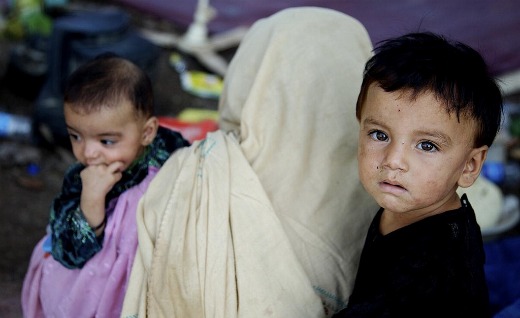
Reports indicate that the hardships from Pakistan’s earlier monsoon floods have been exacerbated by the onslaught of winter.
The floods affected 20 million people — more than 10 percent — of Pakistan’s population of just over 180 million people.
Yet, as the temperature dips, hundreds of thousands of displaced children and adults are susceptible to pneumonia and other cold-related diseases. According to Director of the National Institute of Child Health (Pakistan) Professor Jamal Raza, the flood victims becoming ill from cold related causes, particularly children, could almost double from the current number. Many are living in non-winterized tents, and there are shortages of dry firewood/fuel and other materials, such as adequate clothing, needed to create warmth.
Further, many of the flood ravaged areas from this year’s monsoon remain covered in water and millions are still displaced. Concurrently, many displaced are farmers whose fields are still flooded, and they have no source of livelihood. Food distribution is difficult to carry out under the circumstances.
Concerning the children, Raza says that it will be an uphill battle to save many of the them as they are malnourished, and have experienced a great deal of weight loss due to poor diet. Moreover, he says, their capability for immunity is very low and, accordingly, they are susceptible to a wide range of respiratory diseases. Consequently, there is an urgent need for blankets, quilts and better shelter to fight the cold, as well as provisions for the obvious nutritional and medical needs.
Reports out of Pakistan indicate a further danger caused by the floods: the release of stored toxic chemicals into the flood waters. An article in New Scientist reports the floods released an estimated 3,000 tonnes of toxic chemicals into the environment. The chemicals known as persistent organic pollutants (POPs) include several insect repellents, such as DDT. At the same time, many of them do not biodegrade in nature, and are purportedly linked to hormonal, developmental and reproductive disorders. Pakistan’s floods have awakened some nations and scientists to this ongoing threat as changes in weather patterns become more evident.
Reputable organizations currently active in the relief effort in Pakistan include OXFAM, AmeriCares and United Nations Refugee Agency. If you consider helping the people of Pakistan through a contribution to any one of them, be sure to specify that the donation is for Pakistan flood relief.
Photo: A woman and her two children stand in their makeshift shelter in the northwestern Khyber-Pakhtunkhwa province of Pakistan. Their home was destroyed in the floods that have affected an estimated 2.5 million of the province’s 3.5 million residents.
( UN Photo/UNICEF/ZAK/CC)












Comments